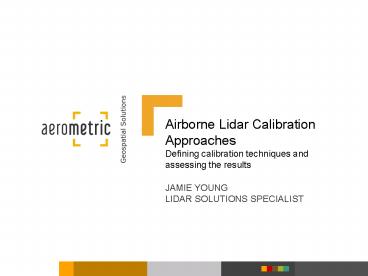Airborne Lidar Calibration Approaches Defining calibration techniques and assessing the results - PowerPoint PPT Presentation
1 / 37
Title:
Airborne Lidar Calibration Approaches Defining calibration techniques and assessing the results
Description:
Airborne Lidar Calibration Approaches Defining calibration techniques and assessing the results JAMIE YOUNG LIDAR SOLUTIONS SPECIALIST – PowerPoint PPT presentation
Number of Views:130
Avg rating:3.0/5.0
Title: Airborne Lidar Calibration Approaches Defining calibration techniques and assessing the results
1
Airborne Lidar Calibration Approaches Defining
calibration techniques and assessing the results
- JAMIE YOUNGLIDAR SOLUTIONS SPECIALIST
2
LiDAR Light Detection and Ranging
Aerial GPS (Global Positioning System) Based on
GPS satellite triangulation, measures the
location of the aircraft up to 0.1 second.
Aerial sensor Collects/scans data, either photons
(reflected light) or laser pulses
IMU (Inertial Measurement Unit) Measures attitude
(pitch/yaw/roll) of aircraft every.002 second.
Ground GPS Measures the location of the aircraft
up to 0.1 second relative to a known ground
position
3
LiDAR Collection Sensors
- Optech
- Leica
- Toposys
- Reigl
Sensor Type Pulse Speed Maximum Altitude
Single Pulse 167 kHz 600m
Multi-Pulse 167 kHz 1100m
4
LiDAR Project Planning
- Plan based on
- Flightline distance limitations
- Workable blocks of data
- Delivery tiles
- Baseline requirements
- Control locations
- Accuracy
- Application
- Topography
5
LiDAR Project Planning
- Day or Night
- Safety considerations
- Leaf on or Leaf off
- Application dependent
- Summer, Spring, Fall, or Winter
- Most collects done in the spring and fall
- Summer collects take place for special
- applications such as forestry
- Winter collects based on geographic
- location
- Weather
- Smoke
6
Establishing Control
- Establish control for entire mapping program
prior to collection using a minimum of two HARN
and/or CORS stations and a minimum of three
Vertical Bench Marks - Perform Fully Constrained Network Adjustment
- Apply HDTP corrections to published
- positions (as necessary)
- Adjustment supports a mapping
- operation not a survey
- Provide adjustment to all LiDAR
- providers involved in the program
- prior to processing
7
Establishing Control
8
GPS
- Static initialization at start
- Static session at end
- PDOP less than 3
- Processing is easier
- Achieve under 5 cm combined solution
9
IMU data
Accelerometer
Gyro
Lever arms
10
Lidar Products
- Standard LIDAR Nominal 1m point spacing
- 15 cm RMSEz vertical accuracy
- Hydro Enforced breaklines
- 20foot nominal widths for rivers
- 1acre lakes/ponds
- General-use, Meets most needs for LiDAR-based DEM
- Supplemental 2 foot accuracy specifications
- USGS Compliant LIDAR Nominal 1m 2m point
spacing - 15 cm RMSEz Vertical Accuracy
- FEMA Map Modernization specified product
- Hydro Enforced Breaklines
- 100foot nominal widths for rivers
- 2acre lakes/ponds
- Points removed off breaklines in separate class
- 1m 3m DEM
- Metadata
- Processing and Vertical Assessment Reports
11
Specialized Lidar
- Data collection as required by client
- Breaklines generated from intensity images
- Contour products
- Sample density 8 points per meter and higher or
4 meter postings and lower - 3-D building extraction
- Clients requiring
- additional classification
- Water
- Vegetation
- Buildings
12
Lidar Calibration - Critically Important
- Optech and Leica have calibration procedures
- Proprietary sensors have custom procedures
- Proper installation and lever arm
- Survey standardization
- GPS survey of antenna
- Total station survey of antenna
- PosPAC location of antenna
13
Lidar Calibration Why Is It Important?
LiDAR CalibrationWhy is this Important?
- Calibration after every installation
- Required to make sure the system is operating
correctly - Calibration every mission
- Provides necessary information in case of
unforeseen occurrences - Fly a minimum of 1 perpendicular line to flight
lines collected for that mission - Ensure ability to correct for roll, pitch,
heading, scan scale and other potential biases - 90 of problems are a result of improper
installation
13
14
Lidar Calibration
- Flying lines perpendicular
- Flying lines parallel
- Calibration every mission
14
15
Lidar Calibration
- Flying a cross flight during collection
15
16
Planar Surface
- Calibration process finds planar surfaces
17
The Plane Results
- Graphically speaking
18
Roof Line Correction
19
Roof Line Correction
20
Checking Calibration
- DZ ortho from several missions
21
Checking Calibration
- Differences between bad calibration and correct
calibration
Unresolved Area Resolved Area
22
Checking Calibration
- 4 missions - old calibration method
23
Difficult Collections and Data
24
Applications
25
Applications
26
Hydro Breakline Collection Process
(LiDARgrammetry)
27
Additional Classification
- Smooth Water Bodies
- Vegetation - Low, Medium, High
- Buildings - Points, Footprints
28
Data1.4 meter collection
DSM- Digital Surface Model
Intensity Image
29
Innovations
30
Whats Important?
- Relative Accuracy
- Removal of Artifacts and Outliers
- How do you quantify this?
- Gaps
- Unacceptable
- Vegetation Removal
- Other Classifications
- How do you quantify this?
- Check Point Verification
- Horizontal Accuracy
- Vertical Accuracy
31
Check Point Surveys
- Five Main Categories
- Hard Surface
- Low Grass
- High Grass
- Brush
- Forest
- What does this mean?
- By region?
- Point distribution?
32
Verification of Point Class
Legend High Vegetation Points Medium
Vegetation Points Bare Soil points
33
Accuracy
- NSSDA standard
- NMAS specification
- FEMA specification
- ASPRS specification
- RMSE
- What accuracy do you need?
- What are you doing?
34
Typically Speaking?
- Vertical accuracy required usually 9 -18.5 cm
- Horizontal accuracy required usually 30 cm 1.0m
- Before MPia, ALS-60, and GEMINI
- Vertical accuracy achieved 7 -12 cm
- Horizontal accuracy achieved 45cm -2.0m
- After MPia, ALS-60 and GEMINI
- Vertical accuracy achieved 3 12 cm
- Horizontal accuracy achieved 10 27 cm
Data meets accuracy specification?
35
Publications
- LIDAR for Dummies
- American Surveyor Mobile Mapping
- Professional Surveyor Calibration Software
36
WILDER LiDAR Blog
- http//bloglidar.wordpress.com
37
Thank You































